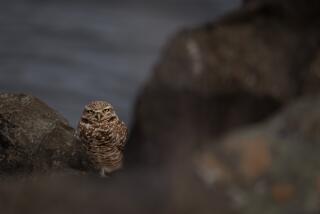A Wise Young Owl and His Pupil : ONE MAN’S OWL <i> by Bernd Heinrich (Princeton University Press: $19.50; 224 pp., illustrated) </i>
- Share via
They both are captivated by it, but there is an essential tension between those who love nature from some abiding passion for birds or bears and the scientists who are driven to understand and to explain it. You see that tension at its worst in conflicts between the animal rights movement, for example, and those who experiment with animals. Happily, there are a few gifted individuals who seem to possess both kinds of fervor, and they are often among the best.
Bernd Heinrich is a nature lover, a scholar and a fine writer. He is professor of zoology at the University of Vermont and has achieved a bit of notoriety for his books, “Bumblebee Economics,” that caught the attention of economists as well biologists, and “In a Patch of Firewood,” a moving account of Heinrich’s growing up a naturalist.
One winter’s day in his habitual reconnaissance of the Vermont woods, Heinrich discovered a Great Horned Owl nestling half-buried and half-alive in the snow. He took it home, whereupon a wood stove and a meal revived it rapidly. For more than two years thereafter, Heinrich and Bubo, as he named the owl (bubo is Latin for owl), were to have a complex relationship: a scientist/wildlife-lover and a half-wild/half-tame Great Horned Owl.
“One Man’s Owl” is a little book that weaves a rich tale. When Heinrich and his family make their summer sojourn to their cabin in the Maine woods, Bubo accompanies them. There Heinrich begins his studies of his house guest: Of the many unfortunate creatures that the cat drags in or that Heinrich can otherwise think of--rabbits, mice, frogs, clams--which will Bubo consume?
And Bubo is the foil for Heinrich’s curiosity about the odd business of “mobbing,” wherein birds of many different species will harass birds of prey, such as hawks, owls and even crows. This behavior has commonly been presumed to deflect predators from the nest or to distract them so that they are unable to prey successfully and leave. But the peculiar situations in which Bubo is--and is not--mobbed lead Heinrich to suspect it is a complex behavior indeed.
Heinrich develops a strong bond with Bubo, and it shows in both their behaviors. But Heinrich is a good scientist, and his book--despite disclaimers--is an excellent example of the dispassionate eye and the disciplined record-keeper, not to mention scientific citations where appropriate, and a generous sprinkling of fine sketches and photographs.
To press the point, everything from its acid-free paper to its excellent references and index proclaim that this is a serious book. And then, there is this owl with a most distinctive personality, one who drives house guests away, learns to live with pet cat and crows, begs mercilessly and wreaks havoc at all hours: a creature who is far more a person than a study subject.
“One Man’s Owl” straddles the line between formal science and sheer love of the wild, and does it beautifully.
More to Read
Sign up for Essential California
The most important California stories and recommendations in your inbox every morning.
You may occasionally receive promotional content from the Los Angeles Times.













